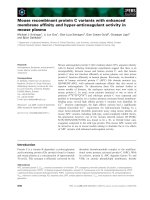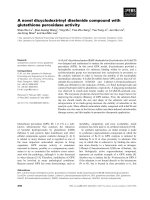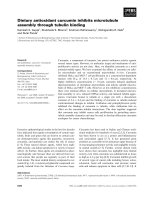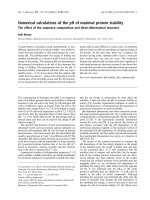Báo cáo khoa học: "Transforming Lattices into Non-deterministic Automata with Optional Null Arcs" pptx
Bạn đang xem bản rút gọn của tài liệu. Xem và tải ngay bản đầy đủ của tài liệu tại đây (491.92 KB, 7 trang )
Transforming Lattices into Non-deterministic Automata with
Optional Null Arcs
Mark Seligman, Christian Boitet, Boubaker Meddeb-Hamrouni
Universit6 Joseph Fourier
GETA, CLIPS, IMAG-campus, BP 53
150, rue de la Chimie
38041 Grenoble Cedex 9, France
seligman@ cer f. net,
{ Christian. Boitet, Boubaker. Meddeb-Hamrouni } @ imag. fr
Abstract
The problem of transforming a lattice into a
non-deterministic finite state automaton is
non-trivial. We present a transformation al-
gorithm which tracks, for each node of an
automaton under construction, the larcs
which it reflects and the lattice nodes at their
origins and extremities. An extension of the
algorithm permits the inclusion of null, or
epsilon, arcs in the output automaton. The
algorithm has been successfully applied to
lattices derived from dictionaries, i.e. very
large corpora of strings.
Introduction
Linguistic data grammars, speech recognition
results, etc. are sometimes represented as lat-
tices, and sometimes as equivalent finite state
automata. While the transformation of automata
into lattices is straightforward, we know of no
algorithm in the current literature for trans-
forming a lattice into a non-deterministic finite
state automaton. (See e.g. Hopcroft
et al
(1979),
Aho
et al
(1982).)
We describe such an algorithm here. Its main
feature is the maintenance of complete records
of the relationships between objects in the input
lattice and their images on an automaton as these
are added during transformation. An extension
of the algorithm permits the inclusion of null, or
epsilon, arcs in the output automaton.
The method we present is somewhat complex,
but we have thus far been unable to discover a
simpler one. One suggestion illustrates the diffi-
culties: this proposal was simply to slide lattice
node labels leftward onto their incoming arcs,
and then, starting with the final lattice node, to
merge nodes with identical outgoing arc sets.
This strategy does successfully transform many
lattices, but fails on lattices like this one:
Figure
1
For this lattice, the sliding strategy fails to pro-
duce either of the following acceptable solu-
tions. To produce the epsilon arc of 2a or the
bifurcation of Figure 2b, more elaborate meas-
ures seem to be needed.
a.
a
b. ~ Figure 2
a
We present our datastructures in Section 1; our
basic algorithm in Section 2; and the modifica-
tions which enable inclusion of epsilon automa-
ton arcs in Section 3. Before concluding, we
provide an extended example of the algorithm
in operation in Section 4. Complete pseudocode
and source code (in Common Lisp) are available
from the authors.
1 Structures and terms
We begin with datastructures and terminology. A
lattice
structure contains lists of lnodes (lattice
nodes), lares (lattice arcs), and pointers to the
lnitlal.lnode and flnal.inode. An lnode has a
label and lists of Incoming.lares and
outgo-
lng.lares.
It also has a list of
a-ares
(automaton
1205
arcs) which
reflect
it A larc has an origin and
extremity. Similarly, an automaton structure
has anodes (automaton nodes), a-arcs, and
pointers to the Initial.anode and final.anode.
An anode has a label, a list of lares which it re-
flects, and lists of Incoming.a-ares and outgo-
lng.a-arcs Finally, an a-arc has a pointer to its
lnode, origin, extremity, and label.
We said that an anode has a pointer to the list of
lares
which it reflects. However, as will be seen,
we must also partition these
lares
according to
their shared origins and extremities in the lattice.
For this purpose, we include the field
late.origin.groups
in each anode. Its value is
structured as follows: (((larc larc ) lnode)
((larc larc ) lnode) ) Each
group
(sublist)
within larc.orlgln.groups consists of (1) a list of
larcs sharing an origin and (2) that origin lnode
itself. Likewise, the late.extremity.groups field
partitions reflected larcs according to their
shared extremities.
During lattice-to-automaton transformation, it is
sometimes necessary to propose the
merging
of
several anodes. The merged anode contains the
union of the larcs reflected by the mergees.
When merging, however, we must avoid the gen-
eration of strings not in the language of the in-
put lattice, or
parasites. An
anode which would
permit parasites is said to be
ill-formed.
An
anode is ill-formed if any larc list in an origin
group (that is, any list of reflected larcs sharing
an origin) fails to intersect with the larc list of
every extremity group (that is, with each list of
reflected larcs sharing an extremity). Such an ill-
formed anode would purport to be an image of
lattice paths which do not in fact exist, thus giv-
ing rise to parasites.
2 The basic algorithm
We now describe our basic transformation pro-
cedures. Modifications permitting the creation
of epsilon arcs will be discussed below.
Lattice.to.automaton,
our top-level procedure,
initializes two global variables and creates and
initializes the new automaton. The variables are
*candidate.a-ares*
(a-arcs created to represent
the current lnode) and
*unconneetable.a-arcs*
(a-arcs which could not be connected when
processing previous lnodes) During automaton
initialization, an initial.anode is created and
supplied with a full set of lares: all outgoing
larcs of the initial lnode are included. We then
visit ever)' lnode in the lattice in topological or-
der, and for each lnode execute our central pro-
cedure, handle.eurrent.lnode.
handle.current.lnode:
This procedure creates an
a-arc to represent the current lnode and connects
it (and any pending a-arcs previously uncon-
nectable) to the automaton under construction.
We proceed as follows: (1) If eurrent.lnode is
the initial lattice node, do nothing and exit. (2)
Otherwise, check whether any a-arcs remain on
*unconnectable.a-arcs*
from previous proc-
essing If so, push them onto
*candidate.a-
arcs*.
(3) Create a candidate automaton arc, or
candidate.a-arc,
and push it onto
*candidate.a-
arcs*. 1
(4) Loop until *candidate.a-arcs* is
exhausted. On each loop, pop a
candidate.a-arc
and try to connect it to the automaton as follows:
Seek potential connecting.anodes on the
automaton If none are found, push
candi-
date.a-arc onto *unconnectable.a-arcs*, oth-
erwise,
try to merge the set of
connect-
Ing.anodes.
CWhether or not the merge succeeds,
the result will be an updated set of
connect-
ing.anodes.)
Finally, execute link.candidate
(below) to connect
candidate.a-arc to connect-
lng.anodes,
Two aspects of this procedure require clarifica-
tion.
First, what is the criterion for seeking potential
connecing.anodes for candidate.a-arc? These
are nodes already on the automaton
whose re-
flected larcs intersect with those of the origin of
candidate.a-arc.
Second, what is the final criterion for the success
or failure of an attempted merge among con-
necting,anodes? The resulting anode must not
be ill-formed
in the sense already outlined
above. A good merge indicates that the a-arcs
leading to the merged anode compose a legiti-
mate set of common prefixes for candidate.a-
arc.
link.candidate: The final procedure to be ex-
plained has the following purpose: Given a can-
didate.a-arc and its
connecting.anodes
(the an-
odes, already merged so far as possible, whose
1 The new a-arc receives the label of the [node which it
reflects. Its origin points to all of that [node' s incoming
larcs, and its extremity points to all of its outgoing
larcs. Larc.origin.groups and
lare.extremity.
groups
are computed for each new anode. None of the
new automaton objects are entered on the automaton
yet.
1206
larcs
intersect
with the larcs of the a-arc origin),
seek a final connecting.anode, an anode to
which the candidate.a-arc can attach (see be-
low). If there is no such anode, it will be neces-
sary to
split
the candidate.a-are using the pro-
cedure split.a-arc. If there is such an anode, a
we connect to it, possibly after one or more ap-
plications of split.anode to split the connect-
ing.anode.
A connecting.anode is one whose reflected larcs
are a
superset
of those of the candidate.a-arCs
origin This condition assures that all of the
lnodes to be reflected as incoming a-arcs of the
connectable anode have outgoing lares leading
to the lnode to be reflected as candidate.a-arc.
Before stepping through the link.candidate pro-
cedure in detail, let us preview split.a-are and
split.anode, the subprocedures which split can-
didate.a-arc or connecting.anodes, and their
significance.
split.a-arc: This subroutine is needed when (1)
the origin of candidate.a-arc contains both ini-
tial and non-initial lares, or (2) no connect-
ing.anode can be found whose larcs were a su-
perset of the larcs of the origin of candidate.a-
are. In either case, we must split the current
candidate.a-are into several new candidate.a-
arcs, each of which can eventually connect to a
connecting.anode. In preparation, we sort the
lares of the current candidate.a-art's origin
according to the connecting.anodes which con-
tain them. Each grouping of lares then serves as
the lares set of the origin of a new candidate.a-
arc, now guaranteed to (eventually) connect. We
create and return these candidate.a-arcs in a list,
to be pushed onto *candidate.a-arcs*. The
original candidate.a-are is discarded.
split.anode. This subroutine splits connect-
ing.anode when either (1) it contains both final
and non-final lares or (2) the attempted con-
nection between the origin of candidate.a-are
and connecting.anode would give rise to an ill-
formed anode. In case (1), we separate final
from non-final lares, and establish a new splittee
anode for each partition. The splittee containing
only non-final larcs becomes the con-
neclng.anode for further processing. In case (2),
some larc origin groups in the attempted merge
do not intersect with all larc extremity groups.
We separate the larcs in the non-intersecting ori-
gin groups from those in the intersecting origin
groups and establish a splittee anode for each
partition. The splittee with only intersecting ori-
gin groups can now be connected to candi-
date.a-arc with no further problems.
In either case, the original anode is discarded,
and both splittees are (re)connected to the a-arcs
of the automaton. (See available pseudocode for
details.)
We now describe link.candidate in detail. The
procedure is as follows: Test whether connect-
ing.anode contains both initial and non-initial
larcs; if so, using split.a-arc, we split candi-
date.a-arc, and push the splittees onto
*candidate.a-arcs* Otherwise, seek a connect-
ing.anode whose lares are a superset of the
lares of the origin of a-arc If there is none,
then no connection is possible during the cur-
rent procedure call. Split candidate.a-are, push
all splittee a-arcs onto *candidate.a-ares*, and
exit. If there is a connecting.anode, then a con-
nection can be made, possibly after one or more
applications of split.anode. Check whether con-
necting.anode contains both final and non-final
larcs. If not, no splitting will be necessary, so
connect candidate.a-arc to connecting.anode.
But if so, split connecting.anode, separating final
from non-final lares The splitting procedure
returns the splittee anode having only non-final
lares, and this anode becomes the connect-
ing.anode Now attempt to connect candi-
date.a-arc to connecting.anode. If the merged
anode at the connection point would be ill-
formed, then split connecting.anode (a second
time, if necessary). In this case, split.anode re-
turns a connectable anode as connecting.anode,
and we connect candidate.a-are to it.
A final detail in our description of lat-
tice.to.automaton concerns the special handling
of the flnal.lnode. For this last stage of the pro-
cedure, the subroutine which makes a new can-
didate.a-arc makes a
dummy
a-arc whose (real)
origin is the final.anode. This anode is stocked
with lares reflecting all of the final larcs. The
dummy candidate.a-arc can then be processed
as usual. When its origin has been connected to
the automaton, it becomes the final.anode, with
all final a-arcs as its incoming a-arcs, and the
automaton is complete.
3 Epsilon (null) transitions
The basic algorithm described thus far does not
permit the creation of epsilon transitions, and
thus yields automata which are not minimal.
However, epsilon arcs can be enabled by varying
the current procedure split.a-arc, which breaks
1207
an unconnectable candidate.a-are into several
eventually connectable a-arcs and pushes them
onto *candidate.a-arcs*.
In the splitting procedure described thus far, the
a-arc is split by dividing its origin; its label and
extremity are duplicated. In the variant
(proposed by the third author) which enables
epsilon a-arcs, however, if the
antecedence con-
dition
(below) is verified for a given splittee a-
arc, then its label is instead 7. (epsilon); and its
extremity instead contains the larcs of a sibling
splittee's origin. This procedure insures that the
sibling's origin will eventually connect with the
epsilon a-arc's extremity. Splittee a-arcs with
epsilon labels are placed at the top of the list
pushed onto *candidate.a-ares* to ensure that
they will be connected before sibling splittees.
What is the antecedence condition? Recall that
during the present tests for split.a-are, we parti-
tion the a-arc's origin larcs. The antecedence
condition obtains when one such larc partition is
antecedent
to another partition. Partition PI is
antecedent to P2 if every larc in P1 is antecedent
to every larc in P2. And larcl is antecedent to
larc2 if, moving leftward in the lattice from
larc2, one can arrive at an lnode where larcl is
an outgoing larc.
A final detail: the revised procedure can create
duplicate epsilon a-arcs. We eliminate such re-
dundancy at connection time: duplicate epsilon
a-arcs are discarded, thus aborting the connec-
tion procedure.
4 Extended example
We now step through an extended example
showing the complete procedure in action. Sev-
eral epsilon arcs will be formed.
We show anodes containing numbers indicating
their reflected lares We show lare.origin.
groups on the left side of anodes when relevant,
and larc.extremity.groups on the right.
Consider the lattice of Arabic forms shown in
Figure 3. After initializing a new automaton, we
proceed as follows:
• Visit lnode W, constructing this candi-
date.a-arc:
®w+
The a-arc is connected to the initial anode.
Visit lnode F, constructing this
date.a-are:
candi-
The only connecting.anode is that con-
taining the label of the initial lnode, >
After connection, we obtain:
W 1
Visit lnode L, constructing
date.a-are:
this ¢andi-
Anodes 1 and 2 in the automaton are con-
necting.anodes. We try to merge them,
and get:
The tentative merged anode is well-formed, and
the merge is completed. Thus, before connec-
tion, the automaton appears as follows. (For
graphic economy, we show two a-arcs with
common terminals as a single a-arc with two
labels.)
1208
w
I ®
Now, in link.candidate, we split
candidate.a-arc
so as to separate inital larcs from other larcs. The
split yields two candidate.a-ares: the first con-
tains arc 9, since it departs from the origin
lnode; and the second contains the other arcs.
@L©
®L©
Following our
basic
procedure, the connection
of these two arcs would give the following
automaton:
However, the augmented procedure will instead
create one epsilon and one labeled transition.
Why? Our split separated larc 9 and larcs (3, 13)
in the candidate.a-are. But larc 9 is antecedent
to larcs 3 and 13. So the splittee
candidate.a-are
whose origin contains larc 9 becomes an epsilon
a-arc, which connects to the automaton at the
initial anode. The sibling splittee the a-arc
whose origin contains (3, 13) is processed as
usual. Because the epsilon a-arc's extremity was
given the lares of this sibling's origin, connec-
tion of the sibling will bring about a merge be-
tween that extremity and anode 1. The result is
as follows:
0 2~ ~'_
.~
2
L©
• Visit lnode S, constructing this
candidate.a-
are:
@s@
Anode 1 is the tentative connection point for the
candidate.a-are, since its larc set has the inter-
section (4, 14) ~qth that of eandidate.a-are's
origin.
Once again, we split candidate.a-are, since it
contains larc 10, one of the
lares
of the initial
node. But larc l0 is an antecedent of arcs 4 and
14. We thus create an epsilon a-arc with larc 10
in its origin which would connect to the initial
anode. Its extremity will contain larcs 4 and 14,
and would again merge with anode 1 during the
connection of the sibling splittee. However, the
epsilon a-arc is recognized as redundant, and
eliminated at connection time. The sibling a-arc
labeled S connects, to anode 1, giving
Visit lnode A, constructing this candidate.a-
are
Q
The two
connecting.anodes
for the candidate.a-
arc are 2 and 3. Their merge succeeds, yielding:
We now split the candidate.a-are, since it finds
no anode containing a superset of its origin's
lares: larcs (12, 19, 21) do not appear in the
merged
connecting.anode.
Three splittee candi-
1209
date automaton arcs are produced, with three
larc sets in their origins: (5, 18), (12, 19), and
(21). But larcs 12 and 19 are antecedents of
larcs 5 and 18. Thus one of the splittees will be-
come an epsilon a-arc which will, after all sib-
lings have been connected, span from anode 1 to
anode 2. And since (21) is also antecedent to (5,
18) a second sibling will become an epsilon a-
arc from the initial anode to anode 2. The third
sibling splittee connects to the same anode, giv-
ing Figure 4.
Visit lnode N, constructing this candidate.a-
are:
The connecting.anode is anode 2. Once again, a
split is required, since this anode does not con-
rain arcs 11, 16, and 22. Again, three candi-
date.a-ares are composed, with larc sets (6, 17),
(11, 16) and (22). But the last two sets are ante-
cedent to the first set. Two epsilon arcs would
thus be created, but both already exist. After
connection of the third sibling splittee, the
automaton of Figure 5 is obtained.
• Visit lnode K, constructing this candidate.a-
arc:
We find and successfully merge connect-
ing.anodes (3 and 4). For reasons already dis-
cussed, the candidate.a-arc is split into two sib-
lings. The first, with an origin containing larcs
(15, 16), will require our first application of
split.anode to divide anode 1. The division is
necessary because the connecting merge would
be ill-formed, and connection would create the
parasite path KTB. The split creates anode 4 (not
shown) as the extremity of a new pair of a-arcs
W, F a second a-arc pair departing the initial
anode with this same label set.
The second splittee larc contains in its origin
state lares 7 and 8. It connects to both anode 3
and anode 4, which successfully merge, giving
the automaton of Figure 6.
Visit lnode T, constructing this candidate.a-
are:
The arc connects to the automaton at anode 5.
Visit lnode B, making this candidate.a-arc:
The arc connects to anode 6, giving the final
automaton of Figure 7.
Conclusion and Plans
The algorithm for transforming lattices into
non-deterministic finite state automata which we
have presented here has been successfully ap-
plied to lattices derived from dictionaries, i.e.
very large corpora of strings (Meddeb-
Hamrouni (1996), pages 205-217).
Applications of the algorithm to the parsing of
speech recognition results are also planned: lat-
tices of phones or words produced by speech
recognizers can be converted into initialized
charts suitable for chart parsing.
References
Aho, A., J.E. Hopcroft, and J.D. Ullman. 1982.
Data Structures and Algorithms.
Addison-
Wesley Publishing, 419 p.
Hopcroft, J.E. and J.D. Ullman. 1979.
Introduc-
tion to Automata Theory, Languages, and
Computation.
Addison-Wesley Publishing,
418 p.
Meddeb-Hamrouni, Boubaker. 1996.
Mdthods et
algorithmes de reprdsentation et de compres-
sion de grands dictionnaires de formes.
Doc-
toral thesis, GETA, Laboratoire CLIPS,
F6deration IMAG (UJF, CNRS, INPG), Univer-
sit6 Joseph Fourier, Grenoble, France.
1210
[ I'" 19 15 x]
Figure 3
Z
Figure 4
z
0
W,F
$
~
L,~ 3
Figure 5
F
W I Figure 6
z E | Figure 7
W,F "
1211









